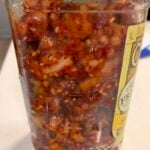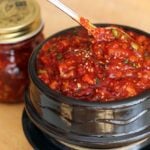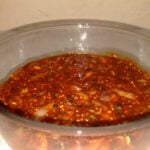I sometimes feel like eating a small morsel of fermented seafood with rice. That’s Korean jeotgal, salty preserved seafood. It tastes salty, chewy, garlicky, gingery, and sweet with a deep, fermented, almost nutty flavor. Today I’m again introducing you to one of my favorite mitbanchan (preserved side dishes that can be refrigerated for a long time). It’s spicy fermented squid jeotgal called ojingeojeot.
Korea is surrounded by ocean on 3 sides, so you can imagine that a variety of fresh fish and seafood dishes are available all year round. My Korean ancestors wanted to enjoy their fresh fish for a long time so they developed a way to preserve them in salt. This jeotgal can be eaten later with rice and other side dishes, or it could be used in kimchi making, too. It’s mostly made with seafood such as anchovies, shrimp, small yellow corvina, or pollock’s intestine, etc.
Among all the different kinds of jeotgal, this ojingeojeot made with squid is my favorite because it’s very easy to make and squid is available pretty much everywhere, fresh or frozen. I use frozen here in New York City because fresh squid is hard to find.
Ingredients
Makes 1 pound of ojngeojeot
- 1 pound cleaned squid (See the video for how to clean squid)
- 3 tablespoons Kosher salt

for the seasoning paste:
- ⅓ cup gochu-garu (Korean hot pepper flakes)
- ⅓ cup rice syrup (or corn syrup)
- 1 teaspoon fish sauce
- 2 green onions, chopped
- 3 garlic cloves, minced
- 1 teaspoon peeled ginger, minced
- 2 green chili peppers, stems removed, deseeded, and chopped
- 1 tablespoon toasted sesame seeds
- 2 teaspoons toasted sesame oil
Directions
Ferment squid:
- In a bowl, mix the squid and the salt, then put it into a glass jar or an airtight container.
- Cover and refrigerate. Let it ferment for 1 month. Mix it up every week or two by turning the jar upside down, so the salty water mixes with the squid. Put it back into the fridge right side up.
 (1 month old fermented squid on the left, fresh salted squid on the right)
(1 month old fermented squid on the left, fresh salted squid on the right) - After 1 month take the squid out of the jar and rinse it in cold running water to remove any excess salt. Drain and dry it out with paper towels.

- Peel the skin off. It can be slippery so I usually use paper towels to get a grip.

- Cut into strips, chop the squid into small pieces, and then gently pound with your knife to soften it. Set aside.


Make seasoning paste:
- Combine hot pepper flakes, rice syrup, fish sauce, green onion, garlic, ginger, and green chili pepper in a large bowl.
- Mix well with a spoon.
Put it together:
Maangchi's Amazon picks for this recipe
It's always best to buy Korean items at your local Korean grocery store, but I know that's not always possible so I chose these products on Amazon that are good quality. See more about how these items were chosen.






















































